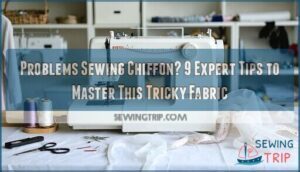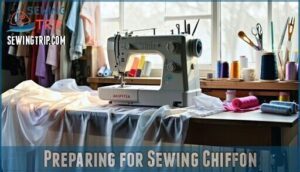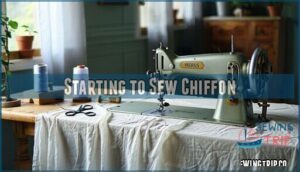This site is supported by our readers. We may earn a commission, at no cost to you, if you purchase through links.

The secret? Use a fine needle (size 60/8), lightweight stabilizer, and adjust your machine’s tension carefully.
Switch to a narrow zigzag stitch instead of straight stitching, and slow down your pace. Don’t fight the fabric—work with its flowing nature.
Your presser foot pressure needs adjusting too, or you’ll end up with puckered seams that’ll make you want to toss the whole project. Master these fundamentals and you’ll transform chiffon from your nemesis into your best friend.
Table Of Contents
- Key Takeaways
- Common Problems When Sewing Chiffon
- Preparing for Sewing Chiffon
- Tips for Cutting Chiffon
- Choosing The Right Needles and Thread for Chiffon
- Adjusting Stitch Length and Tension for Chiffon
- Using The Right Base Plate for Chiffon
- Starting to Sew Chiffon
- Listening to The Fabric While Sewing
- Using French Seams for Chiffon
- Taking Your Time and Enjoying The Process of Sewing Chiffon
- Frequently Asked Questions (FAQs)
- Conclusion
Key Takeaways
- Use the right equipment – You’ll need a fine needle (size 60/8 or 70/10), lightweight thread, and a straight stitch throat plate to prevent the fabric from getting pulled into your machine and creating loose, uneven stitches.
- Master your machine settings – Reduce your top thread tension to 2-3, shorten the stitch length to 12-20 stitches per inch, and switch to a narrow zigzag stitch instead of straight stitching to accommodate chiffon’s movement without puckering.
- Stabilize before you sew – Place tissue paper underneath your chiffon while cutting and sewing to prevent shifting, use fabric weights instead of pins, and consider a walking foot to feed layers evenly through your machine.
- Work slowly and gently – You cannot rush chiffon – reduce your sewing speed, let the feed dogs guide the fabric naturally instead of pulling it, and skip backstitching in favor of tying thread tails manually to avoid snags and tears.
Common Problems When Sewing Chiffon
When you’re working with chiffon, you’ll quickly discover this beautiful fabric has a mind of its own.
The three most common issues you’ll encounter are fabric shifting during cutting and sewing, loose stitches that create uneven seams, and threads getting caught in your machine’s feed dogs.
Fabric Shifting
Chiffon’s slippery nature makes fabric shifting your biggest enemy.
Use tissue paper underneath for chiffon stability and fabric weights instead of pins to prevent fabric slippage. A walking foot feeds layers evenly, while lightweight sewing aids like stabilizers keep everything in place.
Hand basting within seam allowances stops shifting before it starts. To achieve better results, consider using the right sewing chiffon tips to guide your project, focusing on complete concepts and sewing aids for a successful outcome with chiffon stability.
Loose Stitches
Loose stitches can turn your beautiful chiffon project into a frustrating mess.
Start with proper Tension Adjustment – test different settings on fabric scraps until you find the sweet spot. Your Needle Selection matters too; swap that dull needle for a fresh 70/10 or 80/12.
Check your Thread Choice – lightweight threads work better than heavy ones. Adjust your Stitch Length to 12-20 stitches per inch for better control.
Threads Getting Caught
Many sewers face frustrating thread tangles when working with chiffon’s delicate fibers.
Thread tension problems create caught loops and fabric snags that jam your machine. Start by reducing your top thread tension slightly – chiffon needs gentler handling than heavier fabrics.
Check your needle isn’t creating tension issues by switching to a fresh 70/10 sharp point. Clean out any needle clogs from lint buildup.
Test these adjustments on scraps to prevent puckering seams and sewing jams on your final project.
Preparing for Sewing Chiffon
Before you start sewing chiffon, you’ll need to set yourself up for success with the right preparation.
The key is practicing your technique and selecting quality fabric that won’t fight you every step of the way.
Practice and Gain Experience
Master chiffon through dedicated practice sessions with different fabric weights.
Start with inexpensive polyester chiffon before tackling silk varieties, building your confidence with each project.
- Practice basic stitches on fabric scraps to understand tension requirements
- Work with various chiffon weights to develop versatile fabric handling skills
- Complete small projects like scarves before attempting complex garments
- Document successful machine settings for future chiffon sewing challenges
Patient sewing and consistent practice transform chiffon sewing difficulties into manageable techniques.
Experienced sewists know that sewing mastery comes from repeatedly handling delicate fabrics until chiffon techniques become second nature.
Choose The Right Chiffon Fabric
Your fabric choice can make or break your sewing success. Different chiffon types present unique handling chiffon fabric challenges, so selecting the right material sets you up for victory before you even thread your needle.
The right chiffon fabric transforms your project from frustrating struggle to sewing success.
Understanding fabric weight details is essential for achieving the desired texture and drape in your project.
| Chiffon Type | Best For |
|---|---|
| Polyester chiffon | Beginners – stable, affordable, wrinkle-resistant |
| Silk chiffon | Experienced sewers – luxurious drape, evening wear |
| Cotton chiffon | Breathable garments – matte finish, natural feel |
| Double-layer chiffon | Structure needed – less transparent, easier handling |
Consider fabric weight when making your texture choice. Heavier chiffons (higher GSM) offer better control and reduce shifting during construction. For color options, bolder prints appear less sheer than pale shades, affecting your chiffon fabric care requirements and final garment appearance.
Tips for Cutting Chiffon
Cutting chiffon requires precision and patience to prevent the delicate fabric from shifting during the process. Success depends on using proper cutting techniques and the right tools for this slippery material.
Essential cutting techniques for chiffon fabric:
- Rotary cutting with a fresh blade provides cleaner cuts than scissors and reduces fabric distortion
- Fabric stabilizer or tissue paper placed beneath chiffon layers prevents shifting and maintains accuracy
- Grain alignment parallel to the selvage edge guarantees proper drape and prevents bias stretching
- Cutting tools like fabric weights and sharp rotary cutters give you better control than traditional pins
- Chiffon layers should be cut one at a time when possible to minimize movement and mistakes
You’ll find that working on a cutting mat with pattern weights keeps everything stable. Sharp micro-serrated shears work well too, but they require steady hands. Skip the tissue paper between fabric layers – it actually reduces your control over the cutting process.
Focus on getting that grain perfectly aligned first, then take your time with each cut. The goal isn’t speed; it’s accuracy that’ll save you headaches later during construction.
Choosing The Right Needles and Thread for Chiffon
Your needle and thread choices make or break your chiffon project success. Get these fundamentals right, and you’ll avoid the most common sewing disasters that leave beginners frustrated.
Needle Size for Chiffon
Your needle selection can make or break your chiffon project. Choose needle sizes 60/8 or 70/10 for ideal results.
These sharp needles slice through delicate fibers without snagging, preventing needle breakage and fabric runs. Replace needles frequently—dull ones spell disaster for fine threads.
For the best results, understanding sewing needle types is essential for mastering chiffon.
| Needle Size | Best For | Result |
|---|---|---|
| 60/8 | Extremely fine chiffon | Minimal fabric damage |
| 65/9 | Silk chiffon | Clean penetration |
| 70/10 | Standard chiffon | Balanced performance |
| 80/12+ | Not recommended | Visible holes, puckering |
| Microtex sharp | All chiffon types | Precise, snag-free stitching |
Choosing The Right Thread
Why does thread choice make or break your chiffon project? Fine threads, typically 60-100 weight, prevent bulky seams that ruin chiffon’s delicate drape.
Cotton blends and polyester threads offer strength without bulk, while silk thread provides nearly invisible results. Match thread colors precisely since chiffon’s sheerness reveals everything.
Avoid heavy thread types that cause needle breakage and tension issues. Quality thread guarantees smooth sewing.
To achieve superior results, understanding thread weight options is vital for selecting the right thread for chiffon fabrics.
Tips for Sewing Chiffon
Beyond basic thread selection, mastering chiffon sewing techniques requires strategic preparation.
Place fabric stabilizers beneath your work to prevent shifting during stitching. Use a walking foot on your sewing machine to feed layers evenly.
Test thread selection on scraps first, ensuring your chosen weight complements the delicate fibers. These chiffon sewing tips transform common chiffon fabric problems into manageable challenges, making working with chiffon less frustrating.
Choosing the right sewing threads is essential for a successful project.
Adjusting Stitch Length and Tension for Chiffon
Your machine settings make or break chiffon success. Set your stitch length to 12-20 stitches per inch—this shorter setting gives you better stitch control and prevents those frustrating skipped stitches that plague lightweight fabrics.
Next, tackle your tension settings. Reduce your top thread tension to around 2-3, leaving the bobbin tension alone. This prevents puckering seams by allowing your thread choice to flow smoothly through each stitch. Make adjustments in small 0.5 increments—rushing this step leads to needle breakage and wonky seams.
Test these settings on fabric scraps first. Your sewing speed matters too—go slow to maintain proper fabric feed. When your thread tension is balanced, you’ll see smooth, even stitches on both sides without loops or gathering.
Understanding the stitch length mechanism is essential for achieving perfect stitches on delicate fabrics like chiffon. These adjustments work together like a well-tuned orchestra. Get your stitch length and tension settings right, and you’ll transform from chiffon-frustrated to chiffon-confident. Your seams will lie flat, your fabric won’t pucker, and you’ll wonder why chiffon ever seemed intimidating.
Using The Right Base Plate for Chiffon
Your sewing machine’s base plate makes all the difference when sewing chiffon. The standard throat plate opening is too large, allowing delicate fabric to get pulled down into the machine. You’ll want the smallest throat plate available for your model to prevent fabric slipping and needle breakage.
The right base plate creates a stable foundation that keeps your chiffon moving smoothly. Here’s what you need to know about Base Plate Options:
- Straight stitch plate – Single needle hole prevents chiffon from bunching
- Small opening design – Reduces fabric getting caught in the mechanism
- Proper Chiffon Feed – Guarantees even fabric movement without puckering
- Compatible with stabilizer – Works well with tissue paper underneath
- Easy Sewing Machine Setup – Simple swap that transforms your results
Different Throat Plate Sizes affect how your fabric behaves. A smaller opening provides better control and prevents that frustrating moment when your delicate fabric disappears into the machine. This simple change eliminates most feed issues you’ll encounter with lightweight fabrics.
Starting to Sew Chiffon
Your first stitch sets the stage for chiffon success. Position the fabric carefully under your presser foot, ensuring it lies flat without stretching. Start with a gentle touch—chiffon responds better to finesse than force when you’re working with chiffon.
Keep your stitch length between 1.5-2mm for ideal control. This shorter setting prevents fabric slipping while maintaining clean seams. Let your feed dogs do their job by guiding the material naturally rather than pulling it through. Fighting the fabric creates puckering and distortion.
Skip backstitching entirely—it’s a recipe for disaster with delicate fabrics. Instead, leave long thread tails and tie them manually at seam ends. This chiffon handling technique prevents snags and keeps your seams intact.
Reduce your machine’s speed to maintain steady control throughout each seam. Rushing leads to chiffon sewing challenges that could’ve been avoided. Place pins perpendicular to your cutting edge, keeping them close to seam lines for stability.
Remember, sewing chiffon requires patience and respect for the fabric’s delicate nature. Master these sewing basics, and you’ll transform frustrating projects into beautiful garments.
Listening to The Fabric While Sewing
The moment your needle touches chiffon, you’re entering a conversation with the fabric itself. Pay attention to how it responds – does it glide smoothly or resist your guidance? Fabric Tension tells you everything you need to know about your machine’s settings.
Let your machine and chiffon find their rhythm together—when they dance in harmony, magic happens.
When you feel excessive pulling or see fabric slipping beneath the presser foot, that’s your cue to adjust. Develop your Sewing Intuition by maintaining a steady Sewing Rhythm.
Listen for changes in your machine’s hum – a labored sound often signals puckering seams forming. Your Gentle Touch becomes essential here; forcing the fabric through creates wrinkles and distortion. Instead, let the feed dogs guide the delicate fabric naturally.
Watch for Fabric Response signals: bunching indicates tension issues, while smooth feeding means you’ve found the sweet spot. This attentiveness prevents common problems before they ruin your project. Trust your instincts – experienced sewers know that fabric handling techniques rely heavily on feeling rather than just following rules.
Using French Seams for Chiffon
When chiffon sewing techniques demand perfection, French seams deliver unmatched results for delicate fabrics. This edge treatment completely encases raw edges, preventing fraying while creating a professional finish that’s essential for chiffon garment construction.
Start by placing fabric wrong sides together and sewing with a 1/4-inch seam allowance. Trim this initial seam to 1/8-inch, removing excess bulk that could show through sheer fabric. Next, fold the fabric so right sides face together, then stitch again with a 3/8-inch seam allowance.
This seam finishing method creates a clean interior and exterior appearance—vital when working with transparent materials. Unlike zigzag stitching or other fabric stabilizers, French seams won’t damage chiffon’s delicate fibers. The enclosed edges also provide superior durability for sewing lightweight fabrics.
Press each step carefully with low heat and a pressing cloth. This chiffon binding technique requires patience, but you’ll achieve couture-quality results that withstand washing and wear while maintaining the fabric’s elegant drape. To achieve superior results, understanding seam finish techniques is vital for working with delicate fabrics like chiffon.
Taking Your Time and Enjoying The Process of Sewing Chiffon
Rushing through chiffon projects often leads to frustration and disappointing results.
Patient sewing becomes your greatest ally when working with this delicate material.
Your sewing mindset should embrace the slow, methodical approach that chiffon demands.
Think of sewing delicate fabrics as a meditation practice.
Each stitch requires your full attention and respect for the fabric’s nature.
Gentle stitching prevents the common pitfalls that plague hurried sewers.
When you feel tension building in your shoulders or notice yourself pushing the fabric through the machine, that’s your cue to pause and reset.
Chiffon handling improves dramatically when you’re relaxed and focused.
The fabric responds to your energy – tense hands create puckering seams, while calm fingers produce beautiful results.
Set realistic expectations for your sewing sessions.
Plan shorter work periods with breaks between seams.
Fabric respect means accepting that chiffon sewing techniques take longer than working with stable cottons.
You’re not falling behind; you’re mastering a skill that separates amateur sewers from true craftspeople.
Embrace the learning curve and celebrate small victories along the way.
This approach will help you achieve professional-looking results with chiffon.
Frequently Asked Questions (FAQs)
What are some common chiffon sewing problems?
When you’re working with this ethereal fabric, you’ll face slipping layers, puckering seams, and needle breakage. You’ll battle shifting during cutting, tension issues, and fraying edges that’ll test your patience.
How to sew chiffon fabric?
Use fine needles (70/10), lightweight thread, and tissue paper underneath. Cut with sharp rotary cutters, reduce tension, shorten stitch length, and handle gently to prevent shifting and puckering.
Can you sew chiffon with a sewing machine?
Yes, you can sew chiffon with a sewing machine.
Use a fine needle, reduce presser foot pressure, and choose a walking foot for smooth results.
Place tissue paper underneath to prevent slipping and adjust tension settings carefully.
What should I do if my Chiffon is slipping?
Chiffon’s silky texture makes it slip like butter on warm toast.
Place tissue paper underneath while cutting, use fabric weights instead of pins, and cut one layer at a time for control.
How do you fix a chiffon stitch on a sewing machine?
Fixing stubborn chiffon stitches isn’t rocket science—it’s about precision! Use a sharp 70/10 needle, reduce tension, shorten stitch length to 12-20 per inch, and place tissue paper underneath for stability.
Is chiffon hard to sew?
Working with chiffon requires patience and the right approach, but it’s manageable once you master key techniques.
You’ll need sharp needles, proper stabilizers, and gentle handling to prevent puckering and shifting during construction.
What is the best sewing machine setting for chiffon?
Picture delicate silk threads dancing through your machine like morning mist—you’ll need finesse, not force.
Use a fine needle (70/10), reduce tension slightly, set 12-20 stitches per inch, and employ a straight stitch plate for smooth results.
This will help you achieve the desired outcome with your silk threads.
How to sew chiffon without puckering for beginners?
Use a fine needle (70/10), reduce tension, shorten stitch length to 12-20 per inch, and place tissue paper underneath. Test settings on scraps first—you’ll master this delicate fabric!
What stitch length to use for chiffon?
Short stitch lengths aren’t always better—contrary to popular belief, 12-20 stitches per inch prevents chiffon from puckering and gathering.
You’ll achieve smoother seams with shorter stitches rather than standard lengths.
How do I press chiffon without damaging it?
Press chiffon on low heat with a pressing cloth between iron and fabric.
Never drag the iron—lift and place gently.
Steam lightly or use a press cloth to prevent shine and puckering damage.
Conclusion
Mastering problems sewing chiffon will revolutionize your entire sewing universe forever.
You’ve conquered the fabric that makes grown sewers cry and machines surrender in defeat.
Remember your fine needles, stabilizers, and gentle tension adjustments. You’ve learned to work with chiffon’s flowing personality instead of wrestling it into submission.
The narrow zigzag stitches, proper presser foot pressure, and French seams are now your weapons against shifting fabric nightmares.
You’re ready to tackle any chiffon project with confidence and skill.
- https://littlelizardking.com/blogs/little-lizard-king-blog/2019-4-30-chiffon
- https://welikesewing.com/articles/our-guide-to-sewing-chiffon-10-easy-sewing-tips/
- https://www.pinkhollybushdesigns.com/post/2018/08/31/sewing-with-chiffon
- https://reconstructinghistory.com/blogs/blog/five-ways-to-cut-chiffon-with-confidence
- https://www.craftsy.com/post/sewing-chiffon













